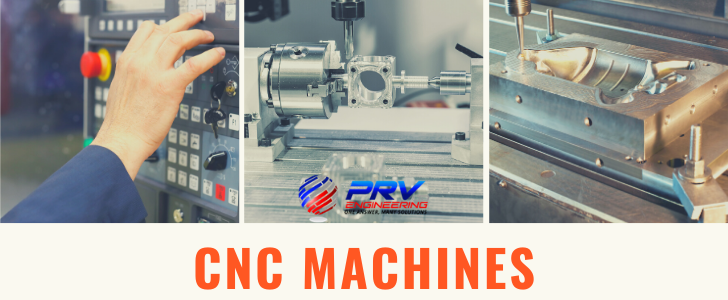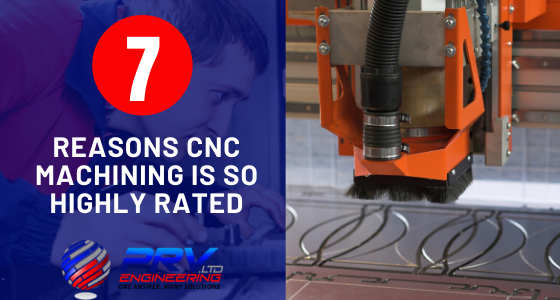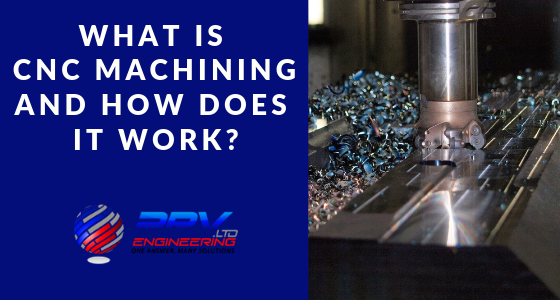Mould tooling is a vital aspect of plastic manufacturing, and while the initial cost of producing the tool can be substantial, the economies of scale make it worth the investment. However, it’s still essential to avoid unnecessary expenses during the design for manufacturing (DFM) process. In this article, we take a closer look at some of PRV Engineering’s top tips for saving money on mould tooling.
Precision engineering is a crucial aspect of modern manufacturing, allowing for the creation of complex products with high levels of accuracy and reliability. The importance of precision engineering cannot be overstated, especially in industries such as aerospace and medical technology. In this article, we will explore the process of moving from blueprint to reality, highlighting the key role that precision engineering plays in this process.
CNC Milling Machines are used to shape metal and other solid materials using specialised cutting tools programmed and managed by Computer Numerical Control (CNC) systems. The machining process creates a specific part or product with the help of CAD software, short for Computer-Aided Design.
Today, you won’t find many items that haven’t gone through CNC milling machines as most sectors rely on this specialised process. Some examples are cars, aeroplanes, machine parts, moulds for household machines, toys and even prosthetics. All of these are likely to have one or several CNC-machined components.
Machining is a term that refers to a variety of technologies and procedures in the manufacturing field. There are also different types of machining processes and tools, where some are standalone while others are used in conjunction with others. To help simplify what machining is, the processes and the techniques, we’ve compiled this comprehensive guide.
CNC Waterjet cutting is a specialised manufacturing process that uses a high-pressure jet of water to cut or shape various types of materials. The power of the CNC waterjet cutting machine comes from a pressurising pump that uses a small precision nozzle. As the water exits the nozzle, it delivers a supersonic stream of water, about three times the speed of sound.
CNC machines, or Computer Numerically Controlled machining, refers to a manufacturing process involving pre-programmed computer software. This dictates the movement of CNC machines which results in several major benefits over other machining methods. Compared to manual processes, CNC machining can help tremendously with improved accuracy and efficiency, faster production, better safety and cost savings.
Today, many sectors in the economy rely on CNC machining including aerospace, automotive, medical manufacturing, construction and woodworking. It has revolutionised manufacturing as other industries have also caught on from window and door manufacturers to those specialising in household appliances and electronics. In this article, you’ll discover the main advantages (and some drawbacks) of CNC machines.
Automating The Manufacturing Process With CNC Machines
Looking back at the history of manufacturing, the early days mostly involved hard, intensive labour. That all changed with the introduction of certain technologies with CNC machining at the top of the list. It has automated most of the manufacturing process that has resulted in less manual labour and increased efficiency which means a reduction in cost.
Thanks to advanced computer software transferring the required data to a CNC machine, it does all the work automatically with very limited input from a person. CNC machining has become more versatile in recent years as some can now even have additional axis. This has increased the types of machines that can effectively manufacture much smaller and more intricate parts with precision.
Recommended: ‘5 Axis Machining In Modern Engineering’
How Does CNC Machining Work?
We touched on the process earlier but here is a more detailed overview. CNC machines work through a numerically controlled computer program using a CNC machining language (‘G-code’). This controls various aspects of the process such as the feed rate, coordination, location and speed. The computer software controls the exact positioning and velocity far better than a human can which is why CNC machining is ideal for manufacturing metal and plastic parts.
The first step is to create a drawing using 2D or 3D CAD software and enter a computer code that the machine will understand. From there, technicians load the program but before any form of machining takes place, a human operator tests everything. This is referred to as a trial run and if better known as “cutting air”. Such a trial run is crucial in the manufacturing process as any mistake regarding speed or tool positioning can lead to broken parts or damaged machines which is unnecessary and avoidable.
Why Manufacturers Prefer CNC Machines
CNC machining has become increasingly popular as it greatly streamlines the manufacturing process. Considering the numerous advantages of CNC machines mean operator-required equipment been replaced in many cases. Regardless of the few disadvantages, manufacturers across all sectors still highly rate CNC machining for fabrication and manufacturing applications. Here are some of the main benefits for your business, manufacturing processes and staff.
CNC Machines Increase Production Speed And Efficiency
CNC machines allow manufacturers to work at a much faster pace while delivering the same high standard of products. Whilst other manufacturing methods require additional resources, CNC machining can do the job without adding to the overheads.
CNC machines can work continuously overnight, weekends and holidays. They will only be stopped for maintenance, repairs or to input a new project. These machines can produce multiple orders much faster than traditional labour-intensive methods. CNC machines require less staff so that means saving time and money on training.
Computer Control Means Fewer Human Errors And Less Material Waste
It’s only natural that people make mistakes but the risk is massively reduced with CNC machining as fewer people are involved in the manufacturing process. Remember, the computer is programmed to do something specific with tight tolerances and specific requirements and will perform as the software dictates no matter what.
It certainly helps that when operators enter the design parameters and specifications that the machine will consistently execute repetitive processes. Everything works according to scale and specifications which leaves almost no room for material waste. This has the potential to help you save big on costs and potential rework time.
CNC Machines Are Safer To Operate
Aside from operators entering the code and maintaining the machines, the process is entirely automated. That means operators don’t have to be anywhere near the cutting tools. This has resulted in decreased occupational health and safety accidents and that is a massive bonus for business and staff. Indeed, operating a CNC machine may not be as simple as using a cordless drill but they are relatively simple to use with some training and practice.
Allows For Advanced Fabrication In A Future-Ready World
CNC plays a pivotal role when it comes to fabrication as several operations are involved which these machines can perform. This includes welding sheets of metal, shearing, punching holes and flame cutting. Due to the incredible precision that CNC machines offer, they can produce extremely complex shapes that manual machines would not be able to replicate. Due to the operator programming the machine, they are highly flexible and should be your first choice.
Considering CNC machines are all around us in almost every industry, implementing it into your business will help you prepare for the future. If you think how much technology has changed in just the last 10 years, the manufacturing sector is looking pretty sharp with CNC in its corner. With the advanced capabilities, you can keep up with all the latest trends, changes in design, building codes and any other standards.
Disadvantages Of CNC Machines
CNC machines are typically more expensive and do require a larger initial investment than manual machines. However, as this technology becomes more widely used and the accepted standard, supply will increase and that means costs could gradually go down.
There is also an element of skills loss as the demand for manual machine operators decreases. This results in fewer new students having to adopt specific skills that may eventually lead to the total loss of long-preserved skills.
At the same time, unemployment is always a big talking point when it comes to any form of automation. The good news is that even though CNC machines require fewer people, there is a growing demand for software engineers and mechanical engineers. If companies and universities adopt and provide the necessary education and training, the skills gap may be closed somewhat in the manufacturing industry.
CNC Machining At PRV Engineering
CNC machines are incredibly versatile and you’ll know how impressive they can be once you see them in action. They serve a multitude of industries with great success, especially in the aerospace sector where they favour five-axis machining which enables them to manage hard-to-cut materials like Inconel.
For reliable and effective CNC machining services, contact PRV Engineering, one of the leading engineering service providers in the UK and Europe. We have state-of-the-art CNC machines to serve our clients from various industries. Some include food and chemical processing, pharmaceutical, railway, military, defence, automotive and aerospace.
Stay up to date on all the latest in engineering, manufacturing and technology by following our blog. You can also join the conversation on Twitter, Facebook, YouTube or LinkedIn using the hashtag #PRVtech.
All materials can be cut by the same CNC Waterjet cutting machine, from soft rubber and plastics to the hardest metals and ceramics. This is hugely beneficial for companies who work within several sectors requiring different materials for various applications.
The aerospace sector wouldn’t exist today without outsourced, precision engineering services and components. While the majority of land vehicles are designed, constructed and tested in-house, the same does not apply to most aircraft.
Considering the number and diversity of aeroplane, spacecraft, satellite and helicopter components, aerospace engineering relies heavily on production chains and outsourced projects. It’s a complex process as each part or component must be designed and built to fit in with the overall plan.
In today’s modern manufacturing world, not too many products are made without CNC machining. This includes the basics like toys, household appliances and machines but also cars, aeroplanes and medical devices among others. CNC machining is incredibly versatile and many industries cannot do without it.
Some of the main industries that rely heavily on CNC machining include aerospace, automotive, medical manufacturing and woodworking. Here, they use it use for various operations such as drilling and routing where the aerospace industry favours CNC machining because it offers the five-axis option when required. This functionality means they can more easily manage hard-to-cut materials such as Inconel.
In healthcare or the medical sector, CNC machining plays an essential role for micro-machining. This involves fabricating all the tiny parts made from different types of materials for various life-saving applications. Examples of CNC machined parts are pacemakers or titanium joints not to mention tools and implements for medical professionals.












Recent Comments